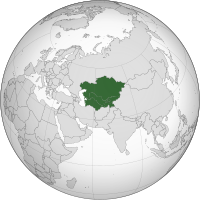
Photo from wikipedia
Abstract A comprehensive understanding of the Neogene paleoenvironmental evolution of Central Asia is important for predicting the future climatic and environmental conditions within the region. However, our understanding of the… Click to show full abstract
Abstract A comprehensive understanding of the Neogene paleoenvironmental evolution of Central Asia is important for predicting the future climatic and environmental conditions within the region. However, our understanding of the relative roles of Tibetan Plateau (TP) uplift and global cooling in driving its paleoenvironmental evolution remain elusive. Here we present two well-dated (~16-5 Ma) independent environmental magnetic records from the northern TP, together with a comprehensive analysis of other well-dated Neogene environmental magnetic datasets for ten other sites from the northern TP. The results indicate synchronous changes in magnetic parameters which we interpret as reflecting a major environmental transition in Central Asia at ~11-9 Ma, which is supported by evidence from multiple independent paleoecological and paleoclimatic studies. A major environmental transition at 11-9 Ma is also supported by the results of linear and non-linear analyses of the magnetic records of the two studied sections. Our analyses reveal that prior to ~11 Ma, the environmental fluctuations within the QB were primarily driven by insolation variations modulated by Earth orbital parameters; however, after ~11 Ma this influence faded and there was a shift from a stable environmental system, characterized by periodic fluctuations, to an unstable system with erratic fluctuations. The timing of this phase shift in the paleoenvironment of Central Asia was not related to global cooling but it coincided with extensive tectonic activity in the TP. Together with conceptual models and previous numerical simulations results, we conclude that a major shift of the dominant driver of Central Asia paleoenvironment occurred at ~11-9 Ma and that uplift of the TP, rather than global cooling, was responsible.
Journal Title: Gondwana Research
Year Published: 2021
Link to full text (if available)
Share on Social Media: Sign Up to like & get
recommendations!